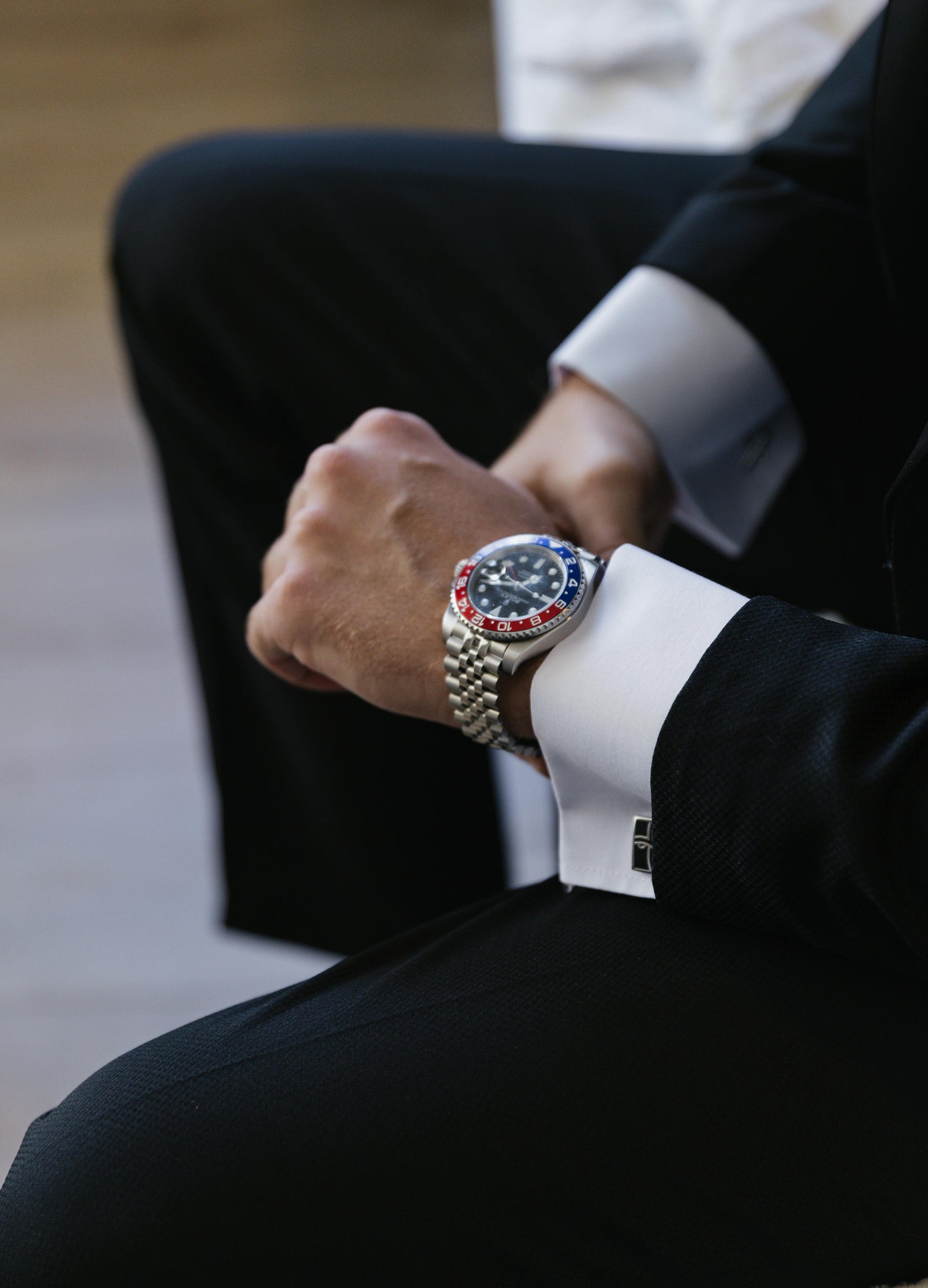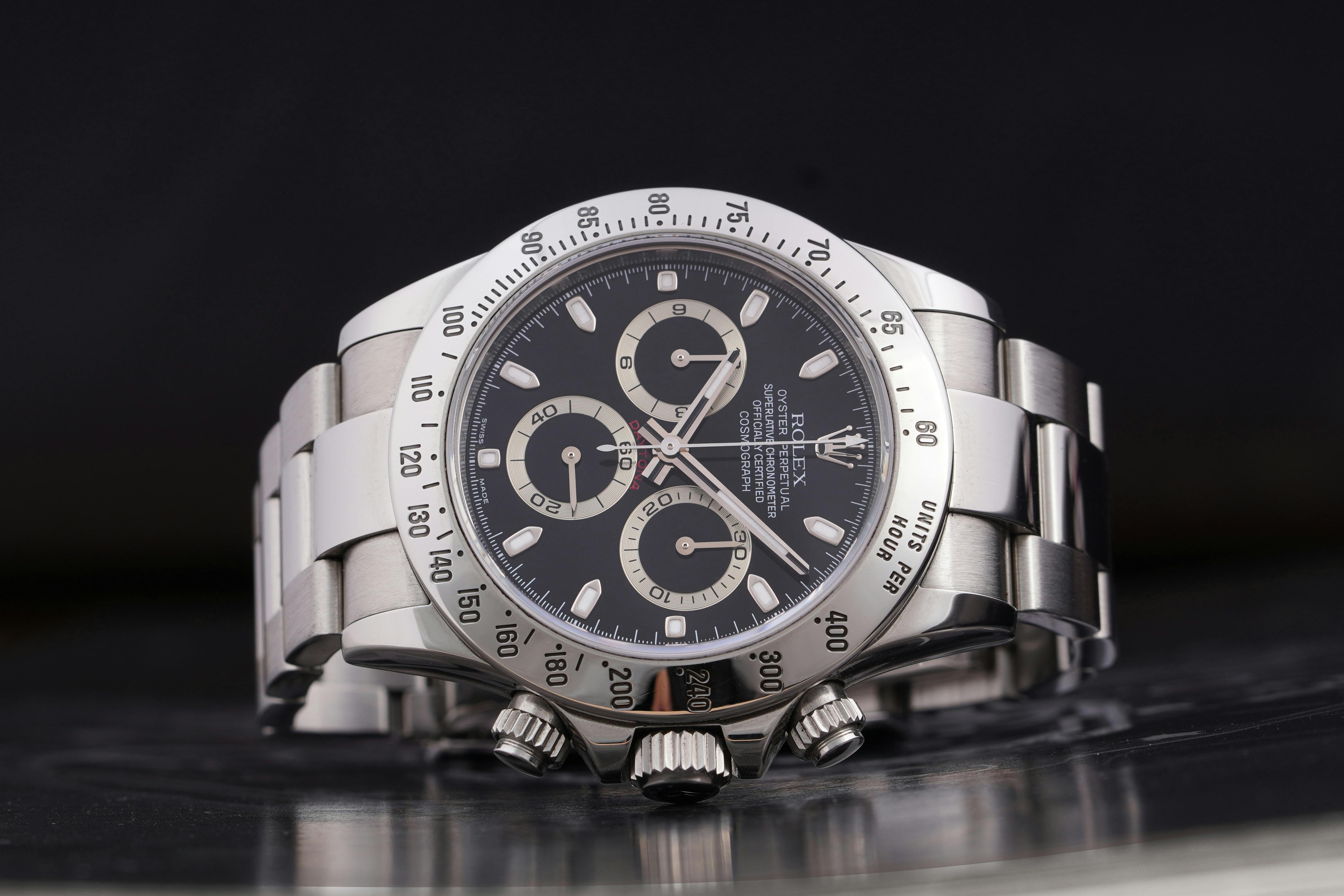Introduction
The Rolex GMT-Master represents one of watchmaking's most successful marriages of utility and style. Created specifically to meet the needs of intercontinental airline pilots in the golden age of commercial aviation, the GMT-Master introduced a revolutionary new function to the wristwatch world: the ability to simultaneously track multiple time zones. This comprehensive examination explores the GMT-Master's journey from specialized pilot's tool to global horological icon over its nearly seven-decade history.
Origins and Purpose (1950s)
The Pan Am Commission
The story of the GMT-Master begins with a specific need from a specific airline. In the early 1950s, Pan American World Airways (Pan Am) was pioneering intercontinental jet travel with new routes that crossed multiple time zones. The airline's pilots needed a reliable way to track both Greenwich Mean Time (GMT, the international aviation standard) and local time simultaneously.
Pan Am approached Rolex to develop a solution, resulting in a collaborative effort that would produce one of the most enduring watch designs in history. While Rolex had already established its reputation for robust tool watches with the Submariner and Explorer models, the GMT-Master would represent a new type of complication for the brand.
Technical Innovation: The Fourth Hand
Rolex's solution was elegant: they added a fourth hand to the watch that revolved once every 24 hours (compared to the main hour hand's two rotations per day). This hand, paired with a rotating 24-hour bezel, allowed pilots to track two time zones at once – typically GMT (later UTC) and local time.
The design was remarkably intuitive:
- The traditional hour, minute, and seconds hands display local time
- The additional 24-hour hand, working in conjunction with the bidirectional rotating bezel, displays a second time zone
- By rotating the bezel, the wearer could even track a third time zone
The First GMT-Master: Reference 6542 (1954-1959)
In 1954, Rolex introduced the first GMT-Master, reference 6542. Its distinctive features included:
- 38mm case size (large for the era)
- Bidirectional rotating 24-hour bezel initially made of Bakelite with radium numerals
- The iconic blue and red "Pepsi" color scheme on the bezel (blue representing nighttime hours 18-6, red representing daytime hours 6-18)
- Modified Caliber 1036 movement (based on the Turn-O-Graph movement)
- No crown guards
- Rivet-style Oyster bracelet
The Bakelite bezel proved fragile and was replaced with an aluminum insert around 1956. The 6542 is notable for its appearance in the James Bond film "Goldfinger" (1964) on the wrist of character Pussy Galore, helping to establish the model's cultural significance.
Second Generation: Reference 1675 (1959-1980)
Refinement and Establishment
The longest-running GMT-Master reference, the 1675 introduced several important refinements:
- Crown guards for improved durability
- Slightly increased case size to approximately 40mm
- Improved movements: initially Caliber 1565, then 1575 starting around 1965
- Addition of hacking seconds function (around 1971) for precise time setting
- Improved dial luminescence, transitioning from radium to tritium
During its production run, the 1675 saw multiple variations:
- The continued "Pepsi" bezel remained the standard
- Introduction of the all-black bezel option in the 1970s
- Various dial changes, including the shift from gilt (gold) lettering to white text
- Both pointed crown guards (early models) and rounded crown guards (later versions)
This long-lived reference firmly established the GMT-Master as a permanent fixture in the Rolex lineup and defined its characteristic appearance.
The GMT-Master 1675/3: Two-Tone Luxury (1970s)
The introduction of the two-tone steel and gold model (reference 1675/3, with "3" denoting the use of gold) represented a significant shift in the GMT-Master's positioning. No longer just a tool watch, the GMT-Master began its evolution toward luxury status while maintaining its functional capabilities. The two-tone version featured:
- Jubilee bracelet option
- Gold winding crown
- Brown dial option
- Brown and gold "Root Beer" bezel option, sometimes nicknamed the "Tiger Eye" or "Clint Eastwood" (as the actor frequently wore this variant)
Third Generation: References 16750, 16760, and 16700 (1980-1999)
Technical Advancements: The Quick-Set Date
The 1980s brought important technical upgrades to the GMT-Master:
- Reference 16750 (1980-1988) introduced the Caliber 3075 movement with quick-set date function
- Higher beat rate of 28,800 vph (up from 19,800 vph)
- Increased water resistance to 100 meters
- Sapphire crystal replaced acrylic around 1986
- White gold indices surrounds for improved corrosion resistance
The GMT-Master II: Reference 16760 "Fat Lady" or "Sophia Loren" (1983-1988)
In 1983, Rolex introduced a significant technical enhancement with the GMT-Master II (reference 16760), which coexisted with the standard GMT-Master for several years. The key innovation was the independent setting of the 24-hour hand, allowing for tracking of three time zones simultaneously.
The 16760 featured:
- Caliber 3085 movement with independently adjustable hour hand
- Thicker case to accommodate the new movement, earning it the nicknames "Fat Lady" or "Sophia Loren"
- Introduction of the red and black "Coke" bezel option
- Sapphire crystal
- Glossier dial finish
Reference 16700: The Last Traditional GMT-Master (1988-1999)
The reference 16700 represented the final evolution of the original GMT-Master concept. While the GMT-Master II continued with more advanced functionality, the 16700 maintained the traditional linked-hand GMT mechanism for those who preferred the original design:
- Caliber 3175 movement
- Slimmer case profile than the GMT-Master II
- Available with either the "Pepsi" bezel or black bezel
- Continued production alongside GMT-Master II for over a decade
Fourth Generation: The Modern GMT-Master II Era (1989-2007)
References 16710, 16713, 16718 (1989-2007)
The reference 16710 streamlined the GMT-Master II design:
- Caliber 3185 movement (later upgraded to Caliber 3186)
- Thinner case profile compared to the "Fat Lady"
- Multiple bezel options: "Pepsi" (red/blue), "Coke" (red/black), and all-black
- Solid end-link (SEL) bracelets introduced in later years
- Holes in the lugs eliminated around 2003
- Luminova replaced tritium for dial luminescence in the late 1990s (later upgraded to SuperLuminova)
During this period, Rolex also offered:
- Reference 16713: Two-tone steel and yellow gold with either "Root Beer" or black bezel
- Reference 16718: 18k yellow gold with either black or brown bezel
This generation saw the GMT-Master II fully take over from the original GMT-Master, which was discontinued in 1999.
Fifth Generation: The Modern Era with Ceramic Bezels (2007-Present)
Reference 116710: The Ceramic Revolution (2007-2019)
In 2007, Rolex introduced a completely redesigned GMT-Master II that featured numerous technical advancements:
- Caliber 3186 movement with improved Parachrom hairspring
- "Super Case" design with broader lugs and larger crown guards
- Ceramic (Cerachrom) bezel insert for vastly improved scratch and fade resistance
- "Maxi Dial" with larger hour markers
- Redesigned bracelet with Easylink 5mm comfort extension
- Polished center links on the bracelet
- Green 24-hour hand
Initially launched only with an all-black bezel (116710LN), this represented the first time a GMT-Master was not available with a two-color bezel at launch. Many enthusiasts wondered if the iconic two-color bezel had been permanently retired due to the technical challenges of creating a two-color ceramic component.
The Return of the Two-Color Bezel
Rolex silenced doubters in 2013 by introducing the GMT-Master II reference 116710BLNR, featuring a blue and black ceramic bezel (nicknamed the "Batman" or "Bruiser"). This demonstrated Rolex's manufacturing prowess, as creating a two-color ceramic component was considered nearly impossible in the industry.
In 2014, Rolex achieved another technical milestone by reintroducing the iconic red and blue "Pepsi" bezel in ceramic—but initially only in white gold (reference 116719BLRO), positioning it as a premium offering.
The Current Generation: References 126710, 126711, 126715, 126719 (2018-Present)
In 2018, Rolex updated the GMT-Master II line with:
- New Caliber 3285 movement with Chronergy escapement
- Extended 70-hour power reserve
- Return to a more traditional case shape with slightly slimmer lugs
- Jubilee bracelet option
- Reintroduction of the "Pepsi" bezel in stainless steel (126710BLRO)
The current range includes:
- 126710BLRO: Stainless steel with red/blue "Pepsi" bezel and Jubilee bracelet
- 126710BLNR: Stainless steel with blue/black "Batman" bezel, available on both Oyster and Jubilee bracelets
- 126711CHNR: Two-tone steel and Everose gold with black/brown "Root Beer" bezel
- 126715CHNR: Full Everose gold with black/brown "Root Beer" bezel
- 126719BLRO: White gold with red/blue "Pepsi" bezel
The Left-Handed GMT-Master II: Reference 126720VTNR (2022)
In 2022, Rolex surprised the watch world with the introduction of the first left-handed GMT-Master II, with the crown and date window positioned on the left side of the case. This model features a distinctive green and black bezel, adding yet another nickname to the collection: the "Sprite" or "Starbucks."
Special Variants and Collectible Models
"Blueberry" GMT
One of the most sought-after vintage GMT variants is the so-called "Blueberry" GMT with an all-blue bezel. While never officially listed in Rolex catalogs, these were reportedly made for specific Eastern European markets or military contracts in the 1970s. Their rarity and uncertain provenance have made authenticated examples extremely valuable.
COMEX Editions
Rolex produced small numbers of GMT-Masters for the commercial diving company COMEX. These rare pieces feature the COMEX logo on the dial and were issued to COMEX personnel who traveled internationally for work.
Military and Airline Editions
Special editions were produced for various air forces (including the UAE Air Force) and airlines (including Pan Am naturally, but also Air-India, Turkish Airlines, and others). These typically feature the organization's logo on the dial and sometimes have special caseback engravings.
Dial Variations
Throughout its history, the GMT-Master has been produced with numerous dial variations that now carry special significance for collectors:
- "Gilt" dials (glossy black with gold text) on early models
- "Radial" dials (where the hour markers are positioned slightly toward the center)
- "Rail" dials (where the chronometer certification lines up perfectly)
- "Spider" dials (where the lacquer has cracked in a distinctive web pattern over time)
- "Nipple" dials (with distinctive raised gold hour markers on two-tone and gold models)
Technical Specifications Across Generations
Early Generation (1954-1959)
- Reference: 6542
- Diameter: 38mm
- Movement: Modified Caliber 1036
- Water Resistance: 50 meters
- Bezel: Initially Bakelite, later aluminum
- Crystal: Acrylic with cyclops lens
Second Generation (1959-1980)
- Reference: 1675
- Diameter: 40mm
- Movement: Caliber 1565, later 1575
- Water Resistance: 50 meters
- Bezel: Aluminum insert
- Crystal: Acrylic with cyclops lens
Third Generation (1980-1999)
- References: 16750, 16760 (GMT-Master II), 16700
- Diameter: 40mm
- Movement: Calibers 3075, 3085, 3175
- Water Resistance: 100 meters
- Bezel: Aluminum insert
- Crystal: Initially acrylic, later sapphire with cyclops lens
Fourth Generation (1989-2007)
- Reference: 16710 (GMT-Master II)
- Diameter: 40mm
- Movement: Caliber 3185, later 3186
- Water Resistance: 100 meters
- Bezel: Aluminum insert
- Crystal: Sapphire with cyclops lens
Fifth Generation (2007-2018)
- Reference: 116710 (GMT-Master II)
- Diameter: 40mm (though appearing larger due to broader lugs)
- Movement: Caliber 3186
- Water Resistance: 100 meters
- Bezel: Ceramic (Cerachrom) insert
- Crystal: Sapphire with cyclops lens
Current Generation (2018-Present)
- Reference: 126710 and variants (GMT-Master II)
- Diameter: 40mm
- Movement: Caliber 3285
- Power Reserve: 70 hours
- Water Resistance: 100 meters
- Bezel: Ceramic (Cerachrom) insert
- Crystal: Sapphire with cyclops lens
- Certification: Superlative Chronometer (-2/+2 seconds per day)
Cultural Impact and Notable Wearers
Aviation Heritage
The GMT-Master has maintained its connection to aviation throughout its history. While originally designed specifically for Pan Am pilots, it has become standard equipment for pilots from many airlines and is recognized as one of the definitive pilot's watches despite competition from aviation-specific brands.
Cinema and Celebrity
The GMT-Master has appeared prominently in films and on the wrists of celebrities:
- Pussy Galore (Honor Blackman) wore a GMT-Master in "Goldfinger"
- Marlon Brando wore a GMT-Master in "Apocalypse Now" (with its bezel removed)
- Clint Eastwood frequently wore his "Root Beer" GMT-Master both on and off-screen
- Tom Selleck wore a "Pepsi" GMT-Master as Thomas Magnum in "Magnum, P.I."
- Sylvester Stallone has been spotted wearing various GMT-Master models
- Daniel Craig has worn a GMT-Master II in his personal life
- Roger Federer is a Rolex ambassador who has been photographed with GMT-Master II models
Nicknames Culture
Few watch models have inspired as rich a nickname culture as the GMT-Master. These unofficial monikers have become standard terminology among enthusiasts:
- "Pepsi" (red and blue bezel)
- "Coke" (red and black bezel)
- "Root Beer" or "Tiger Eye" (brown and gold bezel)
- "Batman" or "Bruiser" (blue and black bezel)
- "Sprite" or "Starbucks" (green and black bezel)
- "Fat Lady" or "Sophia Loren" (the thicker case of the first GMT-Master II)
- "Blueberry" (the rare all-blue bezel variant)
Collecting and Investment Significance
Market Evolution
The GMT-Master market has evolved dramatically over the decades:
- Once readily available at authorized dealers, most steel GMT-Master II models now have multi-year waiting lists
- Secondary market prices frequently exceed retail by significant margins
- Vintage examples in good condition have appreciated substantially, with rare variants achieving six-figure auction results
- The Rolex "bubble" that began in the late 2010s has particularly affected GMT-Master models due to their iconic status
- The "Pepsi" and "Batman" models are among the most sought-after contemporary Rolex watches
Authentication Challenges
With values climbing, authentication has become increasingly important:
- Bezel color and condition are crucial for valuation of vintage pieces
- Period-correct hands and service replacement parts significantly impact collectibility
- Correct serial number ranges and appropriate aging
- Proper bracelet codes and end links for the specific era
- "Frankenwatches" assembled from parts of different watches are unfortunately common
Investment Outlook
While past performance doesn't guarantee future results, the GMT-Master line has shown remarkable investment characteristics:
- Broad appeal beyond just watch enthusiasts due to practicality and recognizable design
- Limited production relative to demand
- Steadily increasing material quality and manufacturing standards
- Strong brand support and continued relevance in the product lineup
- Multi-generational appeal that transcends fashion trends
The GMT-Master as a Practical Tool
Enduring Functionality
Despite its luxury status today, the GMT-Master remains fundamentally practical:
- The GMT function is arguably more useful in today's globalized world than when it was introduced
- The robust construction makes it suitable for everyday wear despite its value
- Water resistance allows it to serve as a true "go anywhere" timepiece
- The date function and easy legibility maintain its utility as a daily timekeeper
How to Use the GMT Function
There are two primary ways to use the GMT functionality:
-
Traditional Method (Original GMT-Master)
- Set the 24-hour hand to GMT/UTC
- Rotate the bezel to align with local time
- The 24-hour hand and bezel show GMT/UTC, while the main hands show local time
-
Independent Hand Method (GMT-Master II)
- Set the 24-hour hand and bezel to the first time zone (often home time)
- Set the independent hour hand to local time
- The bezel can be rotated to track a third time zone
Innovation Timeline
To summarize the key innovations in the GMT-Master's evolution:
1954: Introduction of the first GMT-Master with fourth hand and rotating bezel 1956: Transition from Bakelite to aluminum bezel 1959: Addition of crown guards 1971: Addition of hacking seconds feature 1981: Introduction of quick-set date 1983: Introduction of independently adjustable hour hand (GMT-Master II) 1986: Transition from acrylic to sapphire crystal 2007: Introduction of ceramic "Cerachrom" bezel 2013: First two-color ceramic bezel (blue/black) 2014: Return of the "Pepsi" bezel in ceramic (white gold) 2018: Introduction of new generation movement with extended power reserve 2022: First left-handed configuration with green/black bezel
Conclusion
The Rolex GMT-Master represents one of the most successful watch designs in history, maintaining its essential character while continually evolving over nearly seven decades. From its purposeful birth as an airline navigation tool to its current status as a luxury icon, the GMT-Master has transcended its original mission while never abandoning it.
What makes the GMT-Master particularly special is how it balances utility and style. Unlike many tool watches that sacrifice aesthetics for function or fashion watches that prioritize design over practicality, the GMT-Master achieves both with remarkable harmony. The distinctive two-color bezel—originally implemented purely for functional reasons to distinguish day from night hours—has become one of the most recognizable design elements in watchmaking.
In many ways, the GMT-Master serves as a microcosm of Rolex's broader approach: relentless refinement rather than reinvention. By maintaining the core design language while incrementally improving materials, movements, and manufacturing processes, Rolex has created a timepiece that feels simultaneously modern and timeless.
Whether appreciated for its aviation heritage, its practical functionality, its investment potential, or simply its distinctive aesthetic, the Rolex GMT-Master has earned its place as one of the defining wristwatches of the modern era. Its influence extends far beyond Rolex, having inspired countless dual time zone watches from virtually every major manufacturer. Yet despite these homages and competitors, the original maintains its position as the quintessential traveler's watch—a genuine horological icon by any standard.





Leave a comment
This site is protected by hCaptcha and the hCaptcha Privacy Policy and Terms of Service apply.